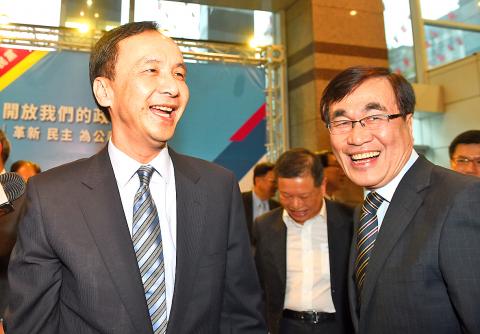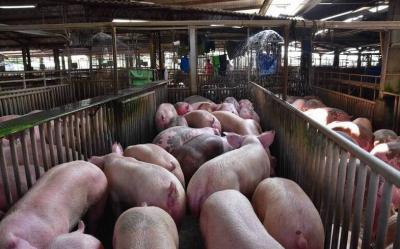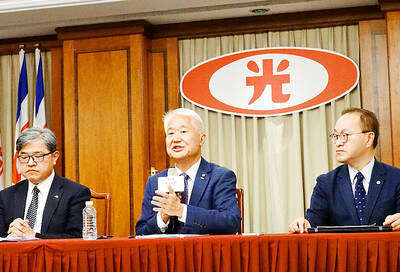Chinese Nationalist Party (KMT) Chairman Eric Chu’s (朱立倫) description of cross-strait relations as two sides “belonging to one China” risked leading to a “misunderstanding” that Taiwan belongs to the People’s Republic of China (PRC), Mainland Affairs Council Minister Andrew Hsia (夏立言) said in Taipei yesterday.
There is a subtle difference between that description and the so-called “1992 consensus” adopted by the government, under which both sides of the Taiwan Strait recognize that there is ‘“one China,” with each side having its own interpretation of what “China” means, Hsia told a meeting of the legislature’s Internal Administration Committee in Taipei.
The government has tried to avoid using the language Chu used because of political sensitivities and has opposed the formula whenever the Chinese mention it, Hsia said.

Photo: Chien Jung-fong, Taipei Times
“We consider it unacceptable. That position remains unchanged,” he said. “We would not choose to use of words he [Chu] did.”
However, Hsia commended Chu’s characterization of the “1992 consensus,” saying that Chu intended to highlight the importance of the consensus — although he used a different way to express it.
“If the ‘one China’ he [Chu] meant was the Republic of China [ROC], as he said it was, of course I am not opposed to the idea,” Hsia said.
Hsia was invited to the meeting to take legislators’ questions over Chu’s just-concluded trip to China, where he met Chinese President Xi Jinping (習近平) and attended the 10th Cross-Strait Economic, Trade and Culture Forum cohosted by the KMT and the Chinese Communist Party (CCP).
Chu’s statement that “both sides [of the Taiwan Strait] belong to ‘one China,’ with differences in connotations and definitions [of ‘one China’]” was at the center of the sometimes heated debate.
Hsia did not voice his opinion about Chu’s definition of the “1992 consensus” until he was grilled by legislators from the Democratic Progressive Party (DPP), the Taiwan Solidarity Union and the People First Party — one after another — about whether the government had shifted its position from the “1992 consensus,” or what it said was “one China, with each side having its own interpretation of what ‘China’ means” to “both sides belonging to ‘one China.’”
In the beginning, Hsia said the phrasing of “both sides belonging to ‘one China,’” was similar to the “1992 consensus” of “one China, with each side having its own interpretation of what ‘China’ means.”
Hsia said Chu was the first person in the ROC to describe cross-strait relations as being “two sides belonging to one China,” a term coined by Beijing and commonly used by Chinese officials — most recently by Xi in March.
He was then corrected by DPP Legislator Lee Chun-yi (李俊俋), who said former KMT chairmen Wu Poh-hsiung (吳伯雄) and Lien Chan (連戰) had both proposed the idea before.
The statement made by former Mainland Affairs Council minister Wang Yu-chi (王郁琦) in March 2013, in response to then-Chinese vice premier Li Keqiang (李克強), who said both sides belong to “one China,” that the characterization was “unacceptable” remains valid, Hsia said.

The combined effect of the monsoon, the outer rim of Typhoon Fengshen and a low-pressure system is expected to bring significant rainfall this week to various parts of the nation, the Central Weather Administration (CWA) said. The heaviest rain is expected to occur today and tomorrow, with torrential rain expected in Keelung’s north coast, Yilan and the mountainous regions of Taipei and New Taipei City, the CWA said. Rivers could rise rapidly, and residents should stay away from riverbanks and avoid going to the mountains or engaging in water activities, it said. Scattered showers are expected today in central and

COOPERATION: Taiwan is aligning closely with US strategic objectives on various matters, including China’s rare earths restrictions, the Ministry of Foreign Affairs said Taiwan could deal with China’s tightened export controls on rare earth metals by turning to “urban mining,” a researcher said yesterday. Rare earth metals, which are used in semiconductors and other electronic components, could be recovered from industrial or electronic waste to reduce reliance on imports, National Cheng Kung University Department of Resources Engineering professor Lee Cheng-han (李政翰) said. Despite their name, rare earth elements are not actually rare — their abundance in the Earth’s crust is relatively high, but they are dispersed, making extraction and refining energy-intensive and environmentally damaging, he said, adding that many countries have opted to

African swine fever was confirmed at a pig farm in Taichung, the Ministry of Agriculture said today, prompting a five-day nationwide ban on transporting and slaughtering pigs, and marking the loss of Taiwan’s status as the only Asian nation free of all three major swine diseases. The ministry held a news conference today confirming that the virus was detected at a farm in Wuci District (梧棲) yesterday evening. Authorities preemptively culled 195 pigs at the farm at about 3am and disinfected the entire site to prevent the disease from spreading, the ministry said. Authorities also set up a 3km-radius control zone

CONCESSION: A Shin Kong official said that the firm was ‘willing to contribute’ to the nation, as the move would enable Nvidia Crop to build its headquarters in Taiwan Shin Kong Life Insurance Co (新光人壽) yesterday said it would relinquish land-use rights, or known as surface rights, for two plots in Taipei’s Beitou District (北投), paving the way for Nvidia Corp to expand its office footprint in Taiwan. The insurer said it made the decision “in the interest of the nation’s greater good” and would not seek compensation from taxpayers for potential future losses, calling the move a gesture to resolve a months-long impasse among the insurer, the Taipei City Government and the US chip giant. “The decision was made on the condition that the Taipei City Government reimburses the related